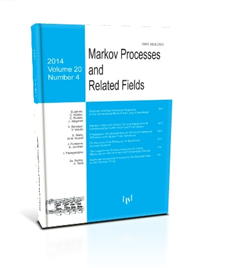Brownian Motion Between Two Random Trajectories
You Lv
2019, v.25, Issue 2
ABSTRACT
Consider the first exit time of one-dimensional Brownian motion $\{B_s\}_{s\geq 0}$ from a random passageway. We discuss a Brownian motion with two time-dependent random boundaries in quenched sense. Let $\{W_s\}_{s\geq 0}$ be an other one-dimensional Brownian motion independent of $\{B_s\}_{s\geq 0}$ and let $\bfP(\cdot|W)$ represent the conditional probability depending on the realization of $\{W_s\}_{s\geq 0}$.
We show that
$$-t^{-1}\ln\bfP^x(\forall_{s\in[0,t]}a+\beta W_s\leq B_s\leq b+\beta W_s|W)$$ converges to a finite positive constant $\gamma(\beta)(b-a)^{-2}$ almost surely and in $L^p~ (p\geq 1)$ if
$a<B_0=x<b$ and $W_0=0.$ When $\beta=1, a+b=2x,$ it is equivalent to the random small ball probability problem in the sense of equidistribution, which has been investigated in \cite{DL2005}. We also find some properties of the function $\gamma(\beta)$. An important moment estimation has also been obtained, which can
be applied to discuss the small deviation of random walk with random environment in time (see \cite{Lv2018}).
%We investigate the probability of a Brownian motion staying between two trajectories which are related to another Brownian motion.
Keywords: Brownian motion, first exit time, random boundary, limit theorem
COMMENTS
Please log in or register to leave a comment

